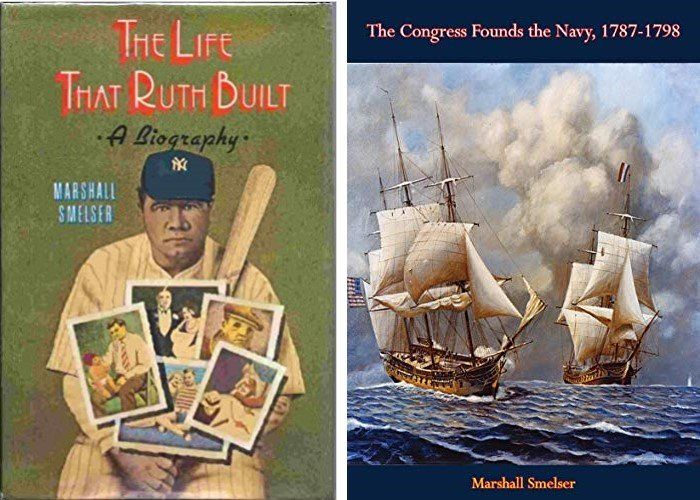Marshall Smelser: Quincy Historian and Biographer

Adams County was home to at least two historians of national eminence. One was Allan Nevins of Columbia University. Nevins was a Camp Point native who twice won the Pulitzer Prize and wrote a multi-volume history of the Civil War and its prologue. The other was Marshall Smelser, a graduate of Quincy high school and Quincy College. He earned his PhD at Harvard under the direction of Samuel Eliot Morison, a Pulitzer Prize historian of maritime and American history. Smelser taught at the University of Notre Dame for almost three decades.
Smelser belonged to the Quincy family known for its photography studio. His parents, Albert and Gladys Alma Smelser, established their business in 1923 in the 600 block of Hampshire street where, The Herald Whig reported on April 4, 1954, it was still operated by his brother, Howard. Marshall married Anna Padberg of Quincy and served as an assistant field director for the Red Cross during World War II. By 1947, the Herald Whig reported on September 21, he and Anna had moved to South Bend, Indiana, with their daughter Elizabeth, to begin his teaching career at Notre Dame.
His academic specialty was the American Revolution and the early decades of the republic. He was a graceful writer. In 1959 he published a study of the American Navy entitled The Congress Founds the Navy 1787-1798 . In acknowledging the help of other scholars, he wrote, “I am profoundly grateful to this entire group. Some are officers by Act of Congress. Others are scholars by acts of university corporations. All are ladies and gentlemen by Act of God.”
Historians Henry Steele Commager and Richard B. Morris, editors of the prestigious New American Nation series for college students, invited Smelser to write a volume, The Democratic Republic, 1801—1815 , published in 1968. The Herald Whig informed its readers of the publication in a January 4, 1969 story by Sarah Lasher headlined, “Former Quincyan Accents History”. She wrote that Smelser had “achieved the nonfiction ideal: a readable chronicle told with the empathy of a fiction writer.” She praised the book because it “covers the crucial years of the young republic…with understanding and frankness, admitting the faults of such patriotic figures as” Jefferson, Madison and John Marshall “but showing them in proportion to their greatness.”
Smelser had a realistic view of the Founders, one almost prescient for our present time. He wrote in 1958, “The years of the administrations of Presidents Washington and Adams are usually regarded by the educated layman…as years in which public life was marked by statesmanlike decorum and a reliance on logic. …While not wholly inaccurate, such a conception neglects to notice that the political activity of the Federalist period was strongly influenced by the passions of hate, anger and fear.”
In 1954 he had studied George Washington, “the most venerated American of that generation, if not of all generations”, and the president’s support of the Alien and Sedition Acts of 1798. Washington, during the summer of 1796, “thought he was being flogged beyond endurance” by a hostile press and political opponents. Despite the infringement by these laws on constitutional rights, Washington “explicitly approved and actively defended them.”
Smelser pursued interests beyond the 18th and 19th century when he undertook a different project: a biography of Babe Ruth, The Life that Ruth Built . The title alluded to the original Yankee Stadium, often called “the house that Ruth built”. For this book, Smelser did not search for documents written a century and a half before. Instead he corresponded with Ruth’s surviving contemporaries, such as the Yankee catcher, Bill Dickey.
Some of that correspondence Smelser donated to the Baseball Hall of Fame, which has since digitalized it online. In a March 3, 1972 letter to Dickey, Smelser said he had “to confess that I grew up in central Illinois and there your teams had to be either the Cubs or Cardinals” in the National League or the White Sox or Browns in the American League. He added, “I never was a Yankee fan until I began getting back your answers. I am one now. I speak of the team.”
He told Dickey that, “Approximately half of the 42 surviving Yankees of the seasons of the 1920-34 have answered my inquiry. This is a sensationally high proportion for an unsolicited questionnaire.” Among his respondents, he said there “was general agreement” that a pitcher facing Ruth should “keep the ball up and throw breaking stuff and changes—never a fast ball over the plate”.
One former player who declined to participate was Leo Durocher. After retirement in 1937, and hoping to become a manager, Ruth had joined the Dodgers as first base coach in 1938. In that job he clashed with Durocher, then team captain, who instead became the manager. Ruth left the Dodgers and quit professional baseball entirely. Also declining was the former Yankee pitcher, Waite Hoyt, who told Smelser that he was writing his own book about Ruth.
Marshall Smelser died in 1978 at the age of 65. He had served as chair of the history department at Notre Dame, enjoying great national respect among his professional colleagues and former students. Anna Smelser served one term in the Indiana state house of representatives, 1953—1955, and died in 1998. Their daughter, Elizabeth, became a nurse at the Mayo Clinic.
SOURCES
“Deaths.” Quincy Herald Whig , April 4, 1954, p. 17.
Dickey, William M., response communication to Marshall Smelser, circa 1972 (Marshall Smelser Collection, National Baseball Hall of Fame, Cooperstown, NY).
Lasher, Sarah. “Former Quincyian Accents History.” Quincy Herald Whig , January 4, 1969, B4.
“Marshall Smelser is Author of New Book.” Quincy Herald Whig , September 17, 1968, B4.
“Marshall Smelsers to Move in Fall to South Bend, Ind.” Quincy Herald Whig , June 17, 1947, 4.
Smelser, Marshall. The Congress Founds a Navy 1787-1798. South Bend, IN: University of Notre Dame Press , 1959.
Smelser, Marshall. The Democratic Republic, 1801-1815. New York: Harper & Row , 1968.
Smelser, Marshall, “The Federalist Period as an Age of Passion”, American Quarterly , (Winter, 1958), pp. 391-419.
Smelser, Marshall, “George Washington and the Alien and Sedition Acts”, The American Historical Review , (Jan., 1954), pp. 322- 334.
Smelser, Marshall, letter to William M. Dickey, March 3, 1972 (Marshall Smelser Collection, National Baseball Hall of Fame, Cooperstown, NY). https://collection.baseballhall.org/PASTIME/letter-marshall-smelser-william-dickey- 1972-march-03.
Smelser, Marshall. The Life that Ruth Built. New York: Quadrangle/New York Times Books, 1975, (reprinted 1993).







